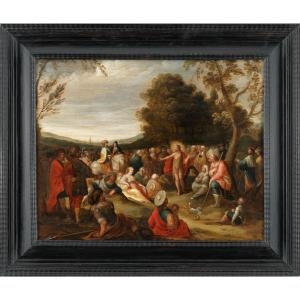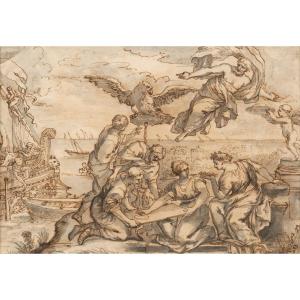This large painting represents Judith, the young princess heroine of a biblical story who saved the city of Bethulia (Judea) by beheading the Babylonian general Holofernes who was besieging the city with his army. Contrary to the contemporary versions of the subject which spread after Caravaggio, the painter does not show the violence of the act but the after; Judith poses proudly, holding her sword like a violinist playing her archer. About to be slipped into a bag, the cadaverous head of Holofernes contrasts with the diaphanous beauty of the young princess highlighted by a Caravaggio-like play of light. The amplitude of the drapes imparts a feeling of movement to the whole. Her long turban tied in her hair and down to the shoulder evokes the Orient, like the Judith painted by Guido Reni around 1620 (kept at the Birmingham Museum of Art). Serene, the heroine of the Jewish people looks outward from the composition, sketching a delicate smile. This composition is inspired by a model painted by Virginia da Vezzo around 1624 for her admission to the Academy of Saint Luke in Rome, and which was interpreted in engraving a few years later by Claude Mellan. If the composition is reminiscent of the female demi-figures of Simon Vouet – of which Virgnia da Vezzo was the wife – our painter moves away from the Roman manner of the latter. His palette is marked by colder tones dominated by gray and where the complexions seem immaculate and cold in comparison with the warmth of Roman paintings. We can see the influence of the style of Guido Reni who, in the 1630s, greatly clarified his chromatic range by adding "an immoderate quantity of white lead" in the words of his biographer Malvasia.
Our painting is superbly highlighted by a carved and gilded wooden frame.
Dimensions: 117 x 99 cm – 138 x 120 cm with frame
Sold with invoice and expertise certificate
Guido Reni (Bologna, Nov. 4, 1575 – Id., August 18, 1642) is one of the most influential Italian painters of his time. Symbol of the Bolognese school, its style is marked by the manner of the artists of the beginning of the Renaissance, whose drawing tends to the search for an ideal of beauty. He is nevertheless a fully Baroque painter at the time of the Counter-Reformation, using chiaroscuro and painting the rolled-up gazes to bring out the divine ecstasy that animated his subjects. An accumulation of gambling debts at the end of his life pushes him to increase the production of his workshop. Thus he surrounded himself with many apprentices who subsequently continued his art, such as Giovanni Andrea Sirani (1616-1670) whose style is close to our painting.
Bibliography:
- BONFAIT, Olivier, Simon Vouet in Italy, Rennes, University Press of Rennes, 2011.
- Simon Vouet: the Italian years, 1613-1627, Chavanne Blandine, Guigon Emmanuel, (exp. cat., Nantes, November 21, 2008 - 23 February 2009; Besançon, March 27 - June 29, 2009), Paris, Hazan, 2008.
- SPEAR, RE, The 'Divine' Guido: Religion, Sex, Money and Art in the World of Guido Reni, New Haven and London, Yale University Press, 1997.
- Guido Reni, 1575-1642, Pinacoteca Nazionale, Bologna, Los Angeles County Museum of Art, Kimbell Art Museum, Fort Worth September 5 - November 10, 1988.
- PIRONDINI Massimo – NEGRO Emilio, La scuola di Guido Reni, Artioli , Modena, 1992
























 Le Magazine de PROANTIC
Le Magazine de PROANTIC TRÉSORS Magazine
TRÉSORS Magazine Rivista Artiquariato
Rivista Artiquariato
